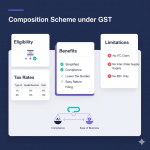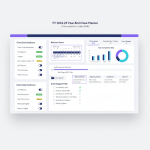Key takeaways
- Foreign currency reconciliation in India requires matching foreign invoices to INR receipts, accounting for fees, timing differences, and multiple exchange rates while ensuring RBI documentation stays complete.
- RBI compliance hinges on correct purpose codes, timely realizations, and attached FIRC, BRC, SOFTEX, and 15CA or 15CB, supported by a clean audit trail.
- Multi currency matching must handle one to many and many to one payments, partial settlements, fees at source, refunds, and chargebacks with clarity.
- A defined exchange rate automation policy, covering RBI reference, AD bank TT, and gateway rates, removes ambiguity and ensures consistent gain or loss calculations.
- Automation reduces manual consolidation of PDFs and CSVs, improves match accuracy, and posts journals directly to systems like Tally or Zoho Books.
- Clear segregation of bank charges, FX conversion fees, and gateway fees prevents ledger distortion and speeds audits.
- Month end revaluation, done automatically, produces accurate unrealized gains or losses that align with AS 11 and Ind AS 21.
- Modern tools such as AI Accountant bring OCR, predictive matching, and compliance packs together for faster closes.
Table of contents
What Is Foreign Currency Reconciliation in the Indian Context?
Foreign currency reconciliation India means matching foreign denominated invoices, USD, EUR, GBP, to INR debits and credits in Indian banking systems, while capturing fees, rate differences, and timing gaps. Your 10,000 USD invoice will not land as one neat INR credit. You might see 825,000 INR after gateway fees, settled days later, at a rate that differs from the invoice date.
Reality adds layers, partial payments and combined payments occur often, payment gateways deduct variable fees, and each inward remittance needs FIRC or e FIRC, export realization requires BRC, and software exports need SOFTEX. Meanwhile, invoices live in Tally or Zoho Books, bank statements arrive as PDFs, and gateway exports come as CSVs.
Think of reconciliation as a moving puzzle, pieces change shape with rates, fees, and timing, while compliance asks for perfect documentation.
Why Foreign Currency Reconciliation Is Complex in India
Multiple exchange rates create confusion
RBI reference rates, AD bank TT buying and selling rates, and gateway rates all exist for different purposes. Choosing the wrong one can misstate books or breach policy. The invoice date rate is not the receipt date rate, and month end revaluation requires marking open items to current rates. This is where exchange rate automation becomes critical.
GST complications
- Exports under LUT do not attract IGST.
- Import of services triggers RCM, needing correct tax ledger mapping.
- Errors cause GST mismatches, input credit issues, and notices.
Fragmented data sources
Bank PDFs, gateway CSVs, and accounting data live in different formats. Manual consolidation introduces errors and delays decision making.
RBI Forex Compliance, The Non Negotiable Requirements
Understanding the regulatory framework
RBI forex compliance under FEMA distinguishes current and capital transactions, every transaction needs a correct purpose code and complete documentation. Recent regulatory updates have extended certain timelines for exporters, including realizations in IFSC contexts, and eased some pressures during volatile trade periods.
Essential documentation
- FIRC or e FIRC, proof of inward remittance.
- BRC, proof of export realization.
- SOFTEX, mandatory for software exports.
- Form 15CA or 15CB, required for outward remittances and TDS compliance, see this RBI eases compliance reference for extended time in merchanting trade in recent guidance.
Critical timelines
RBI sets windows for export proceeds realization, with certain extensions applicable for IFSC. Non adherence can trigger scrutiny. Ensure a complete audit trail with tagged evidence for each transaction, as highlighted in measures to ease challenges for exporters.
Multi Currency Matching, Real World Scenarios
One to many and many to one matches
Clients may settle one invoice with multiple credits, or settle multiple invoices with one consolidated transfer. Manual spreadsheets struggle with these patterns, especially when fees reduce the net receipt.
Handling fees and charges
- Banks may deduct fees at source or post them separately.
- Gateways embed margins in FX rates and levy service fees.
- Segregate bank charges, FX conversion charges, and gateway fees to distinct ledgers to avoid reconciliation gaps.
Managing refunds and chargebacks
Refunds require reversals at contemporary rates, partial refunds need proportional treatment, and documentation should remain airtight. Chargebacks add urgency, requiring clear ledger updates, dispute evidence, and a defensible audit trail.
Other foreign currency scenarios
Vendor advances in foreign currency, security deposits carried at historical rates, and intercompany settlements all introduce unique matching and compliance needs.
Exchange Rate Automation, Implementing the Right Approach
Establishing source hierarchy
Define which rate applies to which context. Many CAs prefer RBI reference rates for reporting, AD bank TT rates for actual settlements, and gateway rates when applicable. Document exceptions, and allow manual override with reasons and approver details.
Realized versus unrealized calculations
Use invoice date rate for initial recognition, then apply receipt date rate for settlement to compute realized gains or losses. Keep both views clear in reports so auditors can trace each amount.
Month end revaluation process
Mark all open foreign receivables and payables to the closing rate. The resulting unrealized gain or loss flows to P and L in line with AS 11 and Ind AS 21. Automation reduces this work from hours to minutes.
Forex Gain Loss Tracking, Getting the Accounting Right
Understanding forex gains and losses
Forex gain loss tracking quantifies the difference between the invoice recognition rate and the settlement rate. Small differences per transaction can compound into material impacts across a portfolio of invoices.
Realized versus unrealized treatment
Realized amounts hit P and L on settlement, unrealized amounts are recorded at revaluation and reversed when realized. Ensure alignment with standards and tax rules.
Automation benefits
Automation standardizes calculations, links journal postings to their source matches, and presents both transaction level and summary views for quick review.
Manual Versus Automated Workflow, A Detailed Comparison
Data ingestion differences
Manual work begins with collecting PDFs, CSVs, and Excel exports. Automated platforms such as AI Accountant process mixed formats, including PDFs and scanned statements using specialized OCR trained on Indian bank layouts.
Matching capabilities
Spreadsheets rely on VLOOKUP and pivot tables. Automated systems predict matches across partials, fees, refunds, and complex patterns, while Exceptions surface in a review queue instead of hiding in rows.
Rate management
Automation applies a clear policy for RBI versus bank TT versus gateway rates, records the chosen source, and enables overrides with a note.
Journal creation and posting
Manual entry is slow and error prone. Automated journals map to correct ledgers and sync to Tally or Zoho Books in near real time.
Compliance documentation and audit trail
Automation centralizes FIRCs and BRCs, tags purpose codes, and exports clean audit packs with user and timestamp logs.
When auditors ask for proof, a single export with documents and rate sources beats days of email and file searches.
How Modern Automation Solves Foreign Currency Reconciliation
Intelligent bank statement processing
Upload PDFs, CSVs, or Excel, the system extracts transactions, cleans narratives, and normalizes fields. OCR tuned for Indian banks reduces manual typing.
Smart multi currency matching
Predictions consider partial settlements, fee deductions, and timing differences. One to many and many to one are handled automatically, with analyst friendly exception queues.
Configurable exchange rate policies
Set the policy once, RBI reference for reporting, AD bank TT for realization, gateway when applicable. The system logs rate sources and selected values every time.
Automated forex gain loss calculations
Forex gain loss tracking runs during each match and at month end for revaluation. Journals flow into your GL with correct ledger mapping and transparent narration.
Comprehensive compliance support
RBI forex compliance features include automatic purpose code tagging, FIRC and BRC attachment, and exportable audit trail packs for reviewers.
Real time dashboards
Visuals show AR and AP by currency, trending FX gains or losses, and outliers such as unusually high fees that require attention.
Recommended Tools for Foreign Currency Reconciliation
1. AI Accountant
Purpose built for Indian workflows, handles multi currency reconciliation with automated FIRC or BRC tracking, purpose code tagging, Indian bank OCR, and Tally or Zoho Books sync.
2. QuickBooks Online
Good for smaller businesses, basic multi currency, added manual steps for Indian compliance.
3. Xero
Strong multi currency with automatic rate updates, Indian documentation often needs additional processes.
4. Zoho Books
Multi currency with India oriented features, comprehensive reconciliation may still require manual steps.
5. FreshBooks
Simple invoicing and reconciliation for freelancers, limited advanced compliance features.
6. Tally Prime
Familiar to Indian accountants, foreign currency features exist, reconciliation remains largely manual without automation.
Implementation Roadmap
Step 1, connect your accounting system
Integrate Tally or Zoho Books. Enable bi directional sync for masters, invoices, and journals.
Step 2, configure bank and gateway feeds
Upload historical statements to train matching, then set up ongoing feeds where available.
Step 3, set exchange rate policies
Define your RBI, AD bank TT, and gateway preferences, enable override controls with documentation.
Step 4, map ledgers and accounts
Map FX gain or loss, bank charges, and gateway fee ledgers, and enable purpose code tagging.
Step 5, run initial matching
Execute multi currency matching, review predictions, resolve exceptions, and let the system learn.
Step 6, post journals and sync
Approve auto generated journals and push to your accounting system, keep a regular sync cadence.
Step 7, generate compliance reports
Export FIRC or BRC links, compile audit packs with traces of rates, documents, and user actions.
Real World Case Study
A SaaS exporter invoices in USD through Zoho Books and receives INR credits in HDFC with gateway deductions.
Before automation
- Two days monthly on spreadsheet based reconciliation.
- Manual rate lookups, missed or incorrect FX journals.
- FIRCs scattered across emails and folders.
After implementing automation
- Under thirty minutes to reconcile, with about seventy five percent auto classification on first pass.
- Consistent rate application and correct FX gain or loss postings.
- Centralized FIRC or BRC with purpose codes, audit prep time cut by eighty percent.
Common Pitfalls and How to Avoid Them
Using the wrong exchange rate
Use RBI reference for reporting, AD bank TT for realized transactions, gateway when appropriate. Document the policy and enforce it in automation.
Missing fee segregation
Post bank charges, FX conversion fees, and gateway fees to distinct ledgers. Automation can split these automatically.
Ignoring partial settlements
Design for one to many and many to one, include proportional FX calculations for partial receipts.
Overlooking value date differences
Track transaction date and value date, use value date for rate selection where policy requires.
Incomplete documentation
Centralize FIRCs, BRCs, SOFTEX, and 15CA or 15CB. Tag purpose codes and keep exportable audit trails.
Security, Scale, and Compliance Considerations
Enterprise grade security
Look for ISO 27001 and SOC 2 Type 2, encryption in transit and at rest, role based access, and full audit logging. See this global regulatory developments report context when evaluating vendor rigor.
Proven scale
Choose platforms that process large transaction volumes, especially with Indian bank and gateway formats.
Regulatory compliance
Automation should enforce purpose codes, attach FIRCs and BRCs, and remain updated with changing RBI and FEMA guidance.
Getting Started with Foreign Currency Reconciliation Automation
Try it yourself
Upload a sample bank statement and test foreign currency reconciliation India. Experience multi currency matching, exchange rate automation, and forex gain loss tracking on your own data.
Quick implementation
Cloud platforms deploy quickly, start with a pilot for one entity or currency, expand as confidence grows.
Measure success
Track monthly hours saved, accuracy of FX journals, and completeness of compliance documentation, many teams report seventy five percent time reduction in the first month.
Conclusion and Next Steps
Foreign currency reconciliation India can be transformed by automation. With clear policies for multi currency matching, exchange rate automation, and forex gain loss tracking, you can stay confidently within RBI forex compliance while closing faster.
Begin with a written rate policy, implement an automation pilot, and iterate. Consider downloading a comprehensive FX reconciliation checklist for India, then align with your AD bank and auditor on documentation practices.
Regulations evolve, always confirm the latest RBI and FEMA requirements with your AD bank or auditor before finalizing entries.
Compliance note, FX rate sources, recognition policies, and documentation controls must align with internal policy and auditor guidance. Regulations may change, confirm current requirements before posting.
References, RBI measures for exporters, RBI eases compliance and extends time, measures to ease exporter challenges.
FAQ
How should a CA set a rate hierarchy for exchange rate automation to satisfy auditors and reduce exceptions?
Define RBI reference as the reporting baseline, AD bank TT as the realized transaction rate, and gateway rates where settlement flows through gateways, then codify this in policy and in your tool. In practice, AI Accountant lets you set this hierarchy once, apply it automatically on every match, and document overrides with notes and user stamps that auditors accept.
What is the correct workflow to compute forex gain or loss for partial receipts against a single foreign invoice?
Recognize the invoice at the invoice date rate, then on each partial receipt, apply the receipt date rate to the proportion settled, compute the realized gain or loss for that portion, and reduce the open balance. AI Accountant automates this proration and posts journals line by line, preserving a clear audit trail.
How do I reconcile one consolidated INR credit that settles multiple USD invoices without losing fee visibility?
Split the consolidated credit into logical matches per invoice using net of fee and fee components, map bank charges and gateway fees to their ledgers, and assign the appropriate purpose code to each match. AI Accountant predicts many to one matches and auto splits fees so your P and L and compliance packs stay accurate.
Which rate should be used for SOFTEX and BRC documentation versus books of account for realized entries?
Use RBI reference rates for standardized reporting in documentation where required, and AD bank TT for realized entries in the GL. Capture both in your working papers. AI Accountant stores the chosen rate source on each transaction, simplifying audit readiness.
How do I handle refunds and chargebacks so that gains or losses and GST implications are accounted correctly?
Reverse the original entry proportionally, apply the refund or chargeback date rate, compute the delta as realized gain or loss, and post fee or chargeback costs to the correct ledgers. For guidance on playbooks, see chargebacks and refund handling guide. AI Accountant links the refund to the original invoice for a clean trail.
What controls should I implement around value date versus transaction date for rate selection?
Document a policy that uses value date for realized rate selection when the bank applies value dated FX, and retain transaction date for operational matching. Tools like AI Accountant store both dates and apply the correct one per policy, which reduces recurring mismatches.
How can I centralize FIRC, BRC, and purpose codes so that RBI reviews are painless during statutory audits?
Adopt a repository where each inward or outward transaction carries its FIRC or BRC link and a purpose code, searchable by invoice or UTR. AI Accountant attaches documents at the transaction level and exports audit packs with one click, including purpose code mapping.
What is the recommended way to run month end revaluation for open items and reverse it in the next period?
At month end, revalue all open foreign currency receivables and payables at the closing rate, post unrealized gain or loss, and reverse the entry at start of the next period. AI Accountant automates this revaluation and reversal with full rate source documentation.
How do I ingest password protected bank PDFs, gateway CSVs, and map them to Tally or Zoho Books reliably?
Use a pipeline that can unlock PDFs securely, parse Indian bank formats with OCR, and normalize columns across gateways. Then map vendors, customers, and ledgers before posting. AI Accountant provides bank statement OCR and direct sync to Tally or Zoho Books for end to end flow.
What exception management process should my finance team follow to minimize manual review time each close?
Define thresholds and rules for auto approve, route only ambiguous cases to reviewers with suggested matches, and track turnaround time. Reference this primer on reconciliation exception management. AI Accountant queues exceptions with reasons, proposed actions, and a clear approve or reject path.
How do I evidence that the exchange rate used on a given day was the correct RBI or bank TT rate if challenged by auditors?
Retain the rate snapshot with source, timestamp, and URL or document extract, and link it to the transaction. AI Accountant stores rate provenance for each posting, so you can show the exact RBI reference or bank TT rate used, with who approved any override.
What reporting should I present to management on FX exposure, realized or unrealized gains, and reconciliation status?
Deliver a dashboard with open AR or AP by currency, aging, realized gains or losses by period, unrealized revaluation by month, exceptions outstanding, and fee analysis by bank or gateway. AI Accountant offers these views in real time, which improves decisions on hedging and pricing.



![All Tally Prime Shortcut Keys For Daily Use [Updated 2026]](https://www.aiaccountant.com/blog/wp-content/uploads/2025/11/Tally_Prime_Shortcut_Keys-150x150.webp?crop=1)
